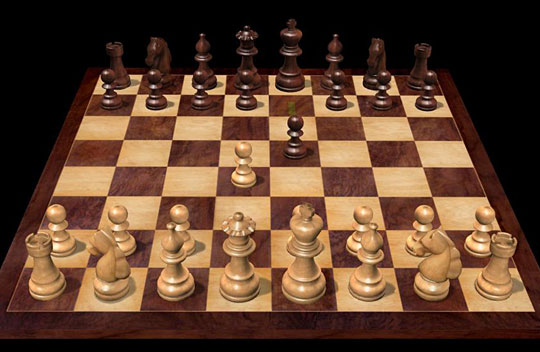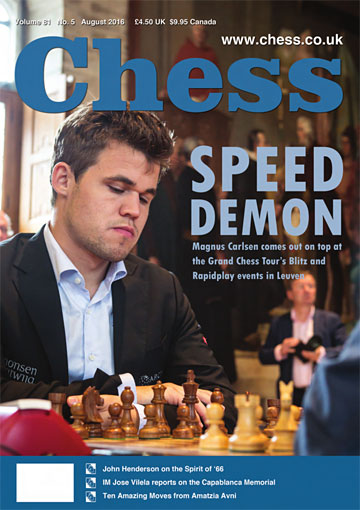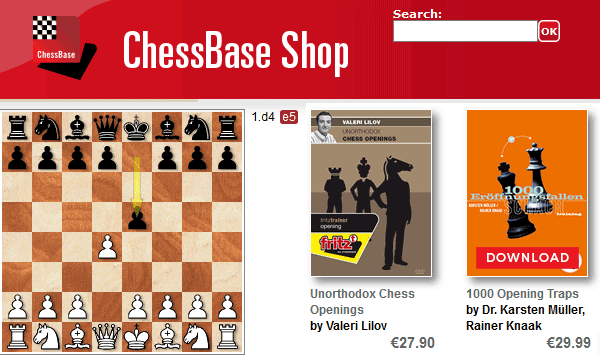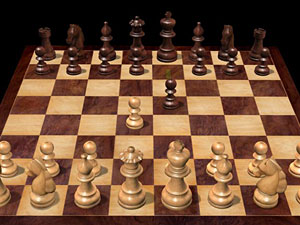Dealing with the Englund
Matthew Lunn analyses and explains how to counter a dubious gambit

I have chosen the Englund Gambit, 1.d4 e5, as the subject of this month’s article for three reasons: (i) It would be advisable knowing how to avoid the ‘one big trap’, which sees White either lose a lot of material, or get mated; (ii) when White avoids the trap, the subsequent lines are an absolute joy to play; and (iii) White has a counter trap, which, while less strong than the main line, leads to a quirky position which would be very instructive to play over the board, thus making it suitable for blitz or study.
You probably know that in the JavaScript replay below you can maximize the board to fill your browser window, flip sides and move pieces to analyse the lines given.

You can even start an engine to assist (by clicking the fan button below the board). And in the end you can save your analysis in your personal cloud database without ever leaving your browser. Full instructions are available on this tutorial page.

[Event "?"] [Site "?"] [Date "????.??.??"] [Round "?"] [White "Englund Gambit"] [Black "?"] [Result "*"] [ECO "A40"] [Annotator "Matthew Lunn"] [PlyCount "31"] [SourceTitle "Chess 2016 #08"] [SourceDate "2016.07.24"] 1. d4 e5 {The Englund Gambit.} 2. dxe5 {Any other move is nonsense.} Nc6 { The main line.} ({Otherwise: -- a)} 2... d6 3. Nf3 (3. exd6 Bxd6 {is still good for White, but proponents of the Englund Gambit are likely to appreciate the small lead in development}) 3... Nc6 {and now White can irritate Black with } ({or} 3... Bg4 {and White can continue with the thematic} 4. Bg5 {, though he is not short of options;} (4. Qd4 {, for instance, is a funny alternative, threatening Qxg4 and exd6, whereby ...Bxd6 is impossible due to the hanging pawn on g7, and meeting} Bxf3 5. exf3 Nc6 {with} 6. Bb5)) 4. Bg5 {, after which Black must make a concession:} Be7 ({if} 4... f6 5. exf6 Nxf6 {and Black really doesn't want a pawn on d6}) 5. Bxe7 Ngxe7 6. exd6 cxd6 {and Black has minimal compensation.}) ({b)} 2... f6 {is a valiant idea, as after} 3. exf6 (3. e4 $5 Nc6 4. Nf3 fxe5 5. Bc4 {when White has easy development, and Black can't castle kingside}) 3... Nxf6 {, Black can claim a bit of compensation for the pawn, as he is ahead in development and may have future prospects on the half-open f-file. However, as ...f6 only makes sense if White captures the pawn, I would advocate 3 e4.}) ({c)} 2... Qe7 {is likely to transpose to the main line after} 3. Nf3 {.}) ({d)} 2... Bc5 {isn't very threatening, given that ...Nf6 is impossible and as a consequence, the f2-pawn is unlikely to be attacked in a hurry:} 3. Nf3 Nc6 ({or} 3... f6 {and again, White's best option is to decline the extra pawn and play something like} 4. e4) 4. Nc3 Nge7 { and there are numerous ways for White to secure his advantage, including the intriguing} 5. Ne4 Bb6 6. h4 {. After a future h5, Black will struggle to win back the pawn, and White can play Bf4 without the possibility of ...Ng6.}) 3. Nf3 Qe7 (3... Nge7 {is a 'playable' alternative, but it's very slow - White can consolidate his advantage with} 4. e4 (4. Bg5 {looks very sensible, but I think the forcing} h6 5. Bh4 g5 6. Bg3 Nf5 {is more appealing for Black than a lot of lines; after the natural} 7. e4 Nxg3 8. hxg3 Bg7 {, Black's position is a little ropey, but he has a strong dark-squared bishop, which compensates a little for his kingside weaknesses}) 4... Ng6 5. Nc3 Ngxe5 6. Nxe5 Nxe5 7. Be3 {, with Be2 and f4 to follow.}) 4. Bf4 {[#]And now, we enter murky waters - with many a trap for the unwary player.} Qb4+ (4... d6 {is favoured by the computer (possibly due to the objective flaws of the main line);} 5. Bg5 ({ the idea being that} 5. exd6 {is met by} Qf6 {. Nevertheless, White seems to be doing pretty well after} 6. e3 Qxb2 7. Nbd2 Bxd6 8. Rb1 {;} (8. --)) 5... Qe6 {, however, isn't as bad for Black as it looks:} 6. exd6 ({and} 6. Nc3 dxe5 {leaves Black with a reasonably playable position}) 6... Bxd6 {offers him a fair bit of developmental compensation.}) 5. Bd2 ({For reasons that I fail to recall, I found myself analysing this gambit with Scottish player Hugh Brechin at the 2011 Pardubice tournament. It was he who first brought the counterintuitive} 5. Nc3 $5 {[#]to my attention. --- Indeed, this move has two possible psychological benefits: -- i. Black realises that you're not going to fall for the 'one big trap'. -- ii. Black may think that you've simply blundered the f4-bishop. --- Either way, if Black captures the piece, you may be entering a line that you've analysed, but he hasn't - thus giving it credibility as a 'counter trap'. --- After} Qxf4 (5... Qxb2 6. Bd2 {transposes to the main line}) 6. Nd5 {(the point, as Black can't prevent Nxc7+, forking the king and rook; Black is likely to regain the knight, and the subsequent positions are delightfully unbalanced), Black has:} Qe4 {, preparing to pick up the e5-pawn, is the most logical. After} (6... Qf5 {looks a reasonable alternative to 6...Qe4, but after} 7. Nxc7+ Kd8 8. Nxa8 Nxe5 {, White has an additional plan:} 9. Qd4 {, threatening the knight on e5 and the a7-pawn. Then} Nc6 ({after} 9... Nxf3+ 10. gxf3 Qxc2 11. Bh3 {, the d7-pawn begins to look a little uneasy; as White is also threatening Qxa7, Black may be advised to swap queens with} Qc5 12. Qd2 Qb4) 10. Qh4+ Nf6 ({after} 10... Qf6 {, the computer recommends} 11. g3 $1 {, meeting} Qxh4 {with} 12. gxh4 {, after which White can enjoy play on the half-open g-file}) ({or} 10... Be7 11. Qg3 {, threatening Qxg7 and Qc7+}) 11. O-O-O {, I think White is clearly better, though there are a lot of double-edged lines that require further analysis: for instance,} Be7 12. Qc4 Ne4 13. Rd5 Qe6 14. Nd4 Qf6 {.}) 7. Nxc7+ Kd8 8. Nxa8 Nxe5 {[#]White has a couple of options:} 9. Ng5 $5 (9. c3 {is very solid, overprotecting the d4-square, and preventing a black piece from landing on b4. Then} b6 10. Nxe5 Qxe5 11. Qa4 {compels Black to play the funny-looking} Qb8 { , after which} 12. O-O-O {leads to the sort of unbalanced position that White can study to his heart's content.} ({However,} 12. Nxb6 {is a mistake, as Black is doing pretty well after} Qxb6 {- although White has won a pawn, his development is stifled by the fact he can't castle queenside, as Black's queen is now eyeing the f2-pawn.})) 9... Qf4 (9... Qb4+ {makes things a lot less complicated, although White can mix things up with} 10. c3 $1 Qxb2 11. Rc1 Qxa2 12. e3 {, after which it is unclear how well placed the black queen is on a2}) 10. Qd5 {leads to very complicated play:} Qxg5 (10... Qb4+ 11. Kd1 Bd6 12. c3 ( 12. e3 {is sensible and good}) 12... Qxb2 13. Rc1 {and things are going to get very complicated after a move like} Ke7 ({or even} 13... Qa3 14. f4 Qa4+ 15. Rc2 Nc4 16. Qe4 Nh6 17. e3 {and goodness knows what's going on.})) 11. Qa5+ b6 12. Qxa7 Bd6 13. h4 {(forcing the queen to commit to a position, and preparing for a future rook lift)} Qf4 14. Qxb6+ Ke7 {and whilst the position is extremely difficult to assess, Black probably has the better practical chances. --- 5 Nc3 looks like good fun, as well as a decent surprise weapon, but we should now return to the main move in practice, 5 Bd2.}) 5... Qxb2 {[#]} 6. Nc3 {White is now significantly better.} (6. Bc3 $4 {is what Black has been hoping for since move one - after} Bb4 {, White loses material, since} 7. Qd2 (7. Bxb4 {is probably best, but Black is simply winning after} Nxb4 {, threatening ... Qxa1 and ...Nxc2+}) 7... Bxc3 8. Qxc3 {runs into} Qc1# {.}) 6... Bb4 {This gives Black the largest chance of survival.} ({Instead, if} 6... Nb4 7. Nd4 a6 {is a less effective way of protecting the b5-square:} ({and now} 7... c6 { looks best, as it's essential to stop a white knight landing on b5. Nevertheless, White is doing very well after} 8. Rb1 Qa3 9. e3 {, where there is a stark contrast between the potential of White's and Black's pieces: for instance,} Nh6 10. Bc4 Qa5 11. a3 Na6 12. f4 {.}) ({Otherwise,} 7... c5 8. Rb1 Qa3 9. Ndb5 Qa5 10. a3 Na6 11. Nd5 {leaves Black with an unplayable position;} (11. --)) 8. a3 Bc5 ({or} 8... Nc6 9. Nb3 {with Ra2, trapping the queen, to follow}) 9. Rb1 Qxa3 10. Nb3 {, with Bc1 to follow, wins the knight, as the only way to save the queen will be to play ...Nxc2+.}) 7. Rb1 Qa3 ({If} 7... Qxc3 8. Bxc3 Bxc3+ 9. Nd2 Bxe5 10. g3 {and Black is struggling to prove any compensation for his material disadvantage.}) 8. Nd5 Bxd2+ ({After} 8... Ba5 { , White gets} 9. Rb5 {in for free, as the threats to a5 and c7 mean that Black has nothing better than} Bxd2+ {, except after} 10. Qxd2 {,} Qxa2 {no longer makes sense, as White's rook isn't hanging.}) 9. Qxd2 Kd8 {[#]} (9... Qxa2 10. Rd1 {makes defending c7 problematic, as} Kd8 {is well met by} 11. Ng5 Nh6 12. e6 $1 {. However, even after the text White has an excellent position, which offers Black minimal aggressive options.}) {White has numerous ways to continue, but I particularly like:} 10. Ng5 {(giving up the e5-pawn for an attack on the black king)} (10. Qg5+ Nge7 11. Nxe7 Nxe7 12. Qxg7 {is also very promising.}) 10... Nxe5 ({If} 10... Nh6 11. f4 {and White is happy to give up the a-pawn:} Qxa2 12. Nc3 {with e3 to follow.}) 11. Rb3 Qf8 (11... Qxa2 12. Qc3 {hits the knight on e5 and the c7-pawn.}) 12. Nxc7 $1 Kxc7 13. Qa5+ {[#]} Kb8 ( 13... Kd6 14. Qb4+) 14. Qxe5+ d6 15. Qf4 Nf6 16. g3 {preparing Bg2, and Black's position is highly dubious, whilst White has yet another attack on the black king to look forward to.} *
The above article appeared in the August 2016 of the British magazine CHESS

CHESS Magazine was established in 1935 by B.H. Wood who ran it for over fifty years. It is published each month by the London Chess Centre and is edited by IM Richard Palliser and Matt Read. The Executive Editor is Malcolm Pein, who organises the London Chess Classic.

CHESS is mailed to subscribers in over 50 countries. You can subscribe from Europe and Asia
at a specially discounted rate for first timers here, or from North America here.
Interested in unorthodox openings and traps? There are a number of interesting ChessBase DVDs that include the Englund. The best way to find them: go to the Position Search page and enter the moves on the board (it is useful to remember this function!).

We particularly recommend the DVD Unorthodox Chess Openings by Valeri Lilov, who devotes 24 lectures to various unorthodox openings - some more popular with super GMs like Alexander Morozevich and others less known - yet all aiming at one and the same goal: to strengthen your opening repertoire and provide you with more weapons for the opening stage. The Chigorin Defence, the Chicago Gambit, and Grob’s Attack are among the systems included for White, with the Hippopotamus Defence and the Elephant Gambit are intended for Black. Lilov effectively teaches the best plans and ideas in each of these unique openings and guarantees success with each and every one of them. Video running time: 5 hrs 16 min.





























